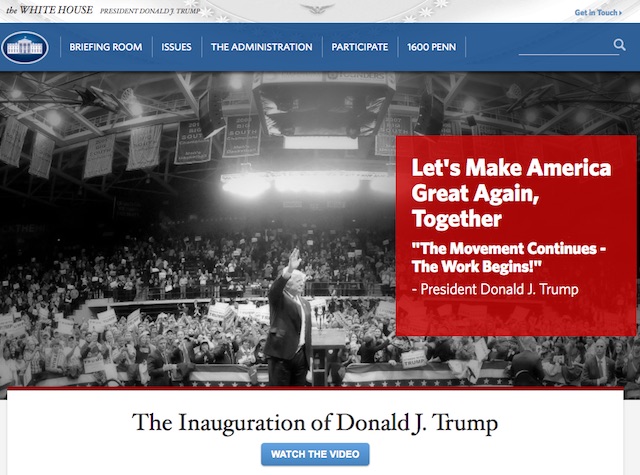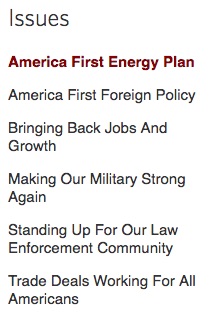The surprising effectiveness of Trump’s whitehouse.gov
When a U.S. administration changes, so does the president’s website. Under Trump, the new whitehouse.gov addresses six issues, each with a short, simple, direct block of text. Unlike the president, it’s focused, clear, and effective.
My social feeds were full of protests when the pages for LGBT rights and climate change disappeared from whitehouse.gov. Were you really expecting Trump to keep this stuff? A new president in the Oval Office means a new website focused on the issues he feels are important.
At whitehouse.gov, you can read and understand Trump’s focus in less than an hour
Here’s what the front page of the new site looks like:

That’s not at all unusual. Amazingly, the “Participate” tab still links to citizen-generated petitions, the most popular of which is a call for Trump to release his tax returns. But let’s concentrate on issues. Trump has a total of six, listed in alphabetical order.

The president has a lot more than six issues to deal with, but Trump has chosen to focus on these six. In contrast to previous administrations, each has a descriptive title, rather than a generic one like “Economy.” Under each issue is a block of text that’s about as straightforward as it gets.
Trump’s statement about jobs is clear and direct
The Issues section of Trump’s whitehouse.gov features short (350-word) pieces in active voice and free of jargon. There are plenty of weasel words, but that’s not unusual for politics. Here’s the complete statement about jobs, with my analysis and commentary:
Bringing Back Jobs and Growth
Since the recession of 2008, American workers and businesses have suffered through the slowest economic recovery since World War II. The U.S. lost nearly 300,000 manufacturing jobs during this period, while the share of Americans in the work force plummeted to lows not seen since the 1970s, the national debt doubled, and middle class got smaller. To get the economy back on track, President Trump has outlined a bold plan to create 25 million new American jobs in the next decade and return to 4 percent annual economic growth.
Analysis: Opens with a clear statement of the problem and the solution, with statistics. Fact checkers will verify that each of the statements here is true — we have lost manufacturing jobs, the workforce participation rate is down, and the middle class has been hammered. And yes, Trump has a bold plan. I doubt that 4% growth is achievable, but that’s the plan.
The plan starts with pro-growth tax reform to help American workers and businesses keep more of their hard-earned dollars. The President’s plan will lower rates for Americans in every tax bracket, simplify the tax code, and reduce the U.S. corporate tax rate, which is one of the highest in the world. Fixing a tax code that is outdated, overly complex, and too onerous will unleash America’s economy, creating millions of new jobs and boosting economic growth.
Analysis: Again, all the statements are active, clear and direct. Tax rates are hard to compare, but the US Tax rate is among the highest on a percentage basis. The statement about fixing the tax code unleashing growth isn’t provable, but it is a clear statement of Trump’s intention.
As a lifelong job-creator and businessman, the President also knows how important it is to get Washington out of the way of America’s small businesses, entrepreneurs, and workers. In 2015 alone, federal regulations cost the American economy more than $2 trillion. That is why the President has proposed a moratorium on new federal regulations and is ordering the heads of federal agencies and departments to identify job-killing regulations that should be repealed.
Analysis: The $2 trillion estimate for the cost of regulations comes from this study by the National Association of Manufacturers. (A link in the whitehouse.gov site would have been nice.) There’s no indication of the cost of not having regulations — what did it cost the economy when poorly regulated mortgages and securities crashed it in 2008? — but you can’t expect balance in a partisan site. And make no mistake — whitehouse.gov is a partisan site now, just as it was under Obama.
With decades of deal-making experience, the President also understands how critical it is to negotiate the best possible trade deals for the United States. By renegotiating existing trade deals, and taking a tough stance on future ones, we will ensure that trade agreements bring good-paying jobs to our shores and support American manufacturing, the backbone of our economy. The President plans to show America’s trading partners that we mean business by ensuring consequences for countries that engage in illegal or unfair trade practices that hurt American workers.
Analysis: Vacuous, but typical for politics. This is a campaign promise, and as such, it’s clear: Trump will renegotiate trade deals.
By standing side-by-side with America’s workers and businesses, the President’s policies will unleash economic growth, create 25 million new jobs, and help Make America Great Again.
Analysis: The 25 million jobs will never happen, but there’s no mistaking where Trump stands.
In contrast to Trump’s public statements, this content is rational and effective
Whether you agree with Trump or not, you ought to understand his communication strategy. Lately, that has appeared to be full of lies and confusion. Trump made the claim, in the absence of any credible evidence, that three to five million people voted illegally and has called for an investigation.
I will be asking for a major investigation into VOTER FRAUD, including those registered to vote in two states, those who are illegal and….
— Donald J. Trump (@realDonaldTrump) January 25, 2017
Listening to this and other bizarre pronouncements about topics like crowd size, you have to wonder if he is unhinged, or if this is part of some Orwellian strategy to call all media-reported facts into question.
If this is Trump’s id, then whitehouse.gov is his superego. It’s rational, straightforward, clear, focused, and remarkably free of made up “alternative facts.” If his public statements reflect the chaotic Steve Bannon side, the web site is more like the efficient Reince Priebus.
Could it be better? Sure. It could include some bullets and graphics, and it would be more believable with links. But if Trump’s spoken communication were as disciplined as this site, then people would be less likely to think he is insane.
How different was Obama’s whitehouse.gov?
Obama’s version of whitehouse.gov is now preserved in the National Archives site. It was far more complex than Trump’s site, with dozens of issues and sub-issues and lots of video and graphics. But that’s not really a fair comparison. What was Obama’s site like when he took office in 2009? Luckily, because of the Internet’s Wayback Machine, we can take a look.
In 2009, Obama’s whitehouse.gov addressed more issues than Trump does, but with generic topic names.

Under “Economy” (notably, not “Jobs”, but remember, Obama was dealing with an economy in crisis) is a bulleted list of topics, and the full text of a long speech, a total of 2,900 words.
All the other topics are similarly complex.
Even though Obama faced a crisis, his priorities on the site reflected a plan to address the full complexity of the issues that America was dealing with. This was probably reassuring to those who believed in his leadership, and perplexing to people with a simpler view of the world.
Trump’s communication is simpler, reflecting a much less nuanced view of the world. I suspect that’s reassuring to people who want him to focus on his stated priorities, and terrifying to those who view things as being more complex — the exact reverse of the situation when Obama took office.
Right now, one thing that concerns me about Trump is his impulsive and undisciplined approach to the world, which is not a good quality in a president. If Trump begins to act with more discipline — in line with what he’s published on whitehouse.gov — we’ll have to deal with an efficient machine pushing forward his plans for the world. If those policies concern you, that’s a completely different kind of thing to fear.
Josh,
I understand you’re on the left side of the political spectrum, but what evidence do you have that supports this statement: “Unlike the president, it’s focused, clear, and effective.”? And why “surprisingly” in the hed? That Trump was able to defeat establishment politicos argues in favor of “effective.” And his inaugural was focused and clear, whether you agree with his plans or not.
BTW, I find your least interesting posts discuss politics. Otherwise, keep up the good work!
I take your point, Lee. I’m talking about communications strategy. The discipline of whitehouse.gov contrasts markedly with the aggressive tweeting and public statements. And the facts on whitehouse.gov are solid and referenceable, which is not true of those tweets and public statements. That’s why I found whitehouse.gov “surprising” — because it doesn’t sound like the rest of Trump’s communications.
Thanks, Josh! I agree that the tweets and the seemingly scattershot comments appear undisciplined. But what if they’re not? Whatever the case, they sure seem effective. After all, he won the job he sought and he’s gotten some companies to act as he wished. Like it or not (I don’t particularly), I’d say his communication “strategy” of tweets, rallies, etc., is working pretty well.
I like these posts. There are plenty of other sources of bullshit, but this political season puts the lessons of Writing Without Bullshit front and center daily. It would be a shame to waste the opportunities.
As usual, very insightful, Josh, thanks for that. Your points on Bannon id and Preibus superego really brought it home for me, I am beginning to see the consistent direction. But one area where the writing is confusing to me is the regulations reduction and how that relates to job growth. Surely the $2T in regulations costs is paid to someone and reducing that means someone is out of a job (or 20 million jobs paying $100k yearly). The word math of losing 20 million jobs to gain 25 million jobs is one of those inconsistencies that keep cropping up. Maybe I’m not the audience?
You’re not getting their point. It’s not that regulations require paying $2 trillion to somebody. It’s that if there were no regulations, they could be more efficient and therefore create $2 trillion of revenue. (Until they had to deal with somebody getting food poisoning or all of us dying from polluted air or whatever the regulations were supposed to prevent). Complying with regulations does cost money, but they are there for a reason.